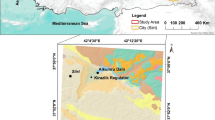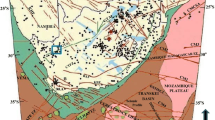Abstract
The Post-Forum Study Tour following the 4th World Landslide Forum 2017 in Ljubljana (Slovenia) focuses on the variety of landslide forms in Slovenia and its immediate NW surroundings, and the best-known examples of devastating landslides induced by rainfall or earthquakes. They differ in complexity of the both surrounding area and of the particular geological, structural and geotechnical features. Many of the landslides of the Study Tour are characterized by huge volumes and high velocity at the time of activation or development in the debris flow. In addition, to the damage to buildings, the lives of hundreds of people are also endangered; human casualties occur. On the first day, we will observe complex Pleistocene to recent landslides related to the Mesozoic carbonates thrust over folded and tectonically fractured Tertiary siliciclastic flysch in the Vipava Valley (SW Slovenia), serving as the main passage between the Friulian lowland and central Slovenia, and thus also an important corridor connecting Northern Italy to Central Europe. A combination of unfavourable geological conditions and intense short or prolonged rainfall periods leads to the formation of different types of complex landslides, from large-scale deep-seated rotational and translational slides to shallow landslides, slumps and sediment gravity flows in the form of debris or mudflows. The second day of the study tour will be held in the Soča River Valley located in NW Slovenia close to the border with Italy, where the most catastrophic Stože landslide in Slovenia recently caused the deaths of seven people, and the nearby Strug landslide, which is a combination of rockfall, landslide and debris flow. The final day of the Post-Forum Study Tour will start in the Valcanale Valley located across the border between Slovenia and Italy, severely affected by a debris flow in August 2003. The flow caused the deaths of two people, damaged 260 buildings; large amounts of deposits blocked the A23 Highway, covering both lanes. In Carinthia (Austria), about 25 km west of Villach, the Dobrač/Dobratsch multiple scarps of prehistoric and historic rockslides will be observed. Dobratsch is a massive mountain ridge with a length of 17 km and a width of 6 km, characterized by steep rocky walls. The 3-day study tour will conclude with a presentation of the Potoška planina landslide, a slide whose lower part may eventually generate a debris flow and therefore represents a hazard for the inhabitants and for the infrastructure within or near the village of Koroška Bela.


Similar content being viewed by others
References
Anderle N (1977) Geologische Karte der Republik Österreich 1:50, 000, Blatt 200, Arnoldstein. Geologische Bundesanstalt (Geological Survey of Austria), Vienna
Boniello MA, Calligaris C, Lapasin R, Zini L (2010) Rheological investigation and simulation of a debris-flow event in the Fella watershed. Nat Hazards Earth Syst Sci 10:989–997
Borga M, Boscolo P, Zanon F, Sangati M (2007) Hydrometeorological analysis of the 29 August 2003 flash flood in the eastern Italian Alps. J Hydrometeorol:1049–1067
Brandt A (1981) Die Bergstürze an der Villacher Alpe (Dobratsch), Kärnten/Östereich Untersuchungen zur Ursache und Mechanik der Bergstürze. Ph.D. thesis. University Hamburg, Germany
Calligaris C, Zini L, Cucchi F (2012) Debris follow rainfall thresholds in Val Canale Valley: first steps into their redefinition. WIT Trans Eng Sci 73:49–57
Četina M, Rajar R, Hojnik T, Zakrajšek M, Krzyk M, Mikoš M (2006) Case study: numerical simulations of debris flow below Stože, Slovenia. J Hydraul Eng 132:121–131
Cruden DM, Varnes DJ (1996) Landslide types and processes. In: Turner AK, Shuster RL (eds) Landslides: investigation and mitigation, Transp res board, spec rep, vol 247, pp 36–75
Fifer Bizjak K, Zupančič A (2009) Site and laboratory investigation of the Slano blato landslide. Eng Geol 105(3–4):171–185
Gosar A, Košták B, Stemberk J, Šebela S (2009) Surface versus underground measurements of active tectonic displacements detected with TM 71 extensometers in Western Slovenia. Acta Carsologica 38(2/3):213–226
Hussin HY, Ciurean R, Frigerio S, Marcato G, Calligaris C, Reichenbach P, Van Westen CJ, Glade T (2015) Assessing the effect of mitigation measures on landslide hazard using 2D numerical runout modelling. Landslide Science for a Safer Geoenvironment 2:679–684
IPCC (2013) Summary for policymakers. In: Stocker TF, Qin D, Plattner GK, Tignor R, Allen SK, Boschung J, Nauels A, Xia Y, Bex V, Midgley PM (eds) Climate change 2013: the physical science basis, contribution of Working Group I to the Fifth Assessment Report of the Intergovernmental Panel on Climate Change. Cambridge University Press, Cambridge, UK & USA
Jakob M (2005) A size classification for debris flows. Eng Geol 79(3–4):151–161
Jemec Auflič M, Šinigoj J, Krivic M, Podboj M, Peternel T, Komac M (2016) Landslide prediction system for rainfall induced landslides in Slovenia (Masprem) Geologija 59 (2): 259–271, doi: 10.5474/geologija.2016.016
Jež J (2007) Reasons and mechanism for soil sliding processes in the Rebrnice area, Vipava valley, SW Slovenia. Geologija 50(1):55–63
Jež J, Mikoš M, Trajanova M, Kumelj Š, Budkovič T, Bavec M (2008) Vršaj Koroška Bela – Rezultat katastrofičnih pobočnih dogodkov = Koroška Bela alluvial fan – The result of the catastrophic slope events; (Karavanke Mountains, NW Slovenia). Geologija 51(2):219–227 (in Slovenian with English abstract)
Komac M (2005) Statistics of the geological map of Slovenia at scale 1:250.000. Geologija 48:117–126. doi:10.5474/geologija.2005.011
Komac M, Ribičič M (2006) Karta verjetnosti pojavljanja plazov v Sloveniji v merilu 1:250.000 = Landslide susceptibility map of Slovenia at scale 1 : 250,000. Geologija 49(2):295–309
Komac M, Kumelj Š, Ribičič M (2009) Model dovzetnosti za pojavljanje drobirskih tokov v Sloveniji v merilu 1: 250.000 = Debris-flow susceptibility model of Slovenia at scale 1 : 250,000. Geologija 52(1):87–104 (in Slovenian with English abstract)
Komac M, Holly R, Mahapatra P, Van der Marel H, Bavec M (2015) Coupling of GPS/GNSS and radar interferometric data for a 3D surface displacement monitoring of landslides. Landslides 12:241–257
Legros F (2002) The mobility of long-runout landslides. Eng Geol 63:301–331
Logar J, Fifer Bizjak K, Kočevar M, Mikoš M, Ribičič M, Majes B (2005) History and present state of Slano blato landslide. Nat Hazards Earth Syst Sci 5:447–457
Maček M, Majes B, Petkovšek A (2016) Lessons learned from 6 years of suction monitoring of the Slano blato landslide. Rivista Italiana di Geotechnica 1:21–31
Majes B, Petkovšek A, Logar J (2002) Primerjava materialnih lastnosti drobirskih tokov iz plazov Stože, Slano blato in Strug = The comparison of material properties of debris flows from Stože, Slano blato and Strug landslides. Geologija 45(2):457–463 (in Slovenian with English abstract)
Martín Pérez A, González-Acebrón L, Košir A, Popit T (2016) Sandstone diagenesis, salt-induced weathering and landslide formation: the case of Slano Blato landslide, Slovenia. 32nd IAS International Meeting of Sedimentology, Marrakech
Merchel S, Mrak I, Braucher R, Benedetti L, Repe B, Bourlès DL, Reitner JM (2014) Surface exposure dating of the Veliki vrh rock avalanche in Slovenia associated with the 1348 earthquake. Quat Geochronol 22:33–42
Mikoš M, Četina M, Brilly M (2004) Hydrologic conditions responsible for triggering the Stože landslide, Slovenia. Eng Geol 73(3–4):193–213
Mikoš M, Vidmar A, Brilly M (2005) Using a laser measurement system for monitoring morphological changes on the Strug rock fall, Slovenia. Nat Hazards Earth Syst Sci 5(1):143–153
Mikoš M, Brilly M, Fazarinc R, Ribičič M (2006a) Strug landslide in W Slovenia: a complex multi-process phenomenon. Eng Geol 83(1–3):22–35
Mikoš M, Fazarinc R, Ribičič M (2006b) Sediment production and delivery from recent large landslides and earthquake-induced rock falls in the Upper Soča River Valey, Slovenia. Eng Geol 86:198–210
Mikoš M, Petkovšek A, Majes B (2009) Mechanism of landslides in over-consolidated clays and flysch. Landslides 6:367–371
Mikoš M, Jemec Auflič M, Ribičič M, Čarman M, Komac M (2013) Earthquake-induced landslides in Slovenia: historical evidence and present analyses. V: UGAI, Keizo (ur.), YAGI, Hiroshi (ur.), WAKAI, Akihito (ur.). Earthquake-induced landslides. In: Proceedings of the International Symposium on Earthquake-induced Landslides, Kiryu, Japan, 2012. Springer Verlag, Berlin, Germany, pp 225–233
Peternel T, Kumelj Š, Oštir K, Komac M (2017) Monitoring the Potoška planina landslide (NW Slovenia) using UAV photogrammetry and tachymetric measurements. Landslides 14(1):395–406. doi:10.1007/s10346-016-0759-6
Petkovšek A, Fazarinc R, Kočevar M, Maček M, Majes B, Mikoš M (2011) The Stogovce landslide in SW Slovenia triggered during the September 2010 extreme rainfall event. Landslides 8(4):499–506
Placer L (1981) Geološka zgradba jugozahodne Slovenije = Geologic structure of southwestern Slovenia. Geologija 24(1):27–60 (in Slovenian with English abstract)
Placer L, Jež J, Atanackov J (2008) Structural aspect on the Slano blato landslide (Slovenia). Geologija 51:229–234 (In Slovenian with English abstract)
Popit T, Košir A, Šmuc A (2013) Sedimentological characteristics of quaternary deposits of the Rebrnice slope area (SW Slovenia). V Knjiga sažetka. 3. znanstveni skup Geologija kvartara u Hrvatskoj s međunarodnim sudjelovanjem, Zagreb, 21st–23rd March 2013. Zagreb, HAZU.
Popit T, Rožič B, Šmuc A, Kokalj Ž, Verbovšek T, Košir A (2014) A lidar, GIS and basic spatial statistic application for the study of ravine and palaeo-ravine evolution in the upper Vipava valley, SW Slovenia. Geomorphology 204:638–645
Pulko B, Majes B, Mikoš M (2014) Reinforced concrete shafts for the structural mitigation of large deep-seated landslides: an experience from the Macesnik and the Slano blato landslides (Slovenia). Landslides 11(1):81–91
Ribičič M, Kočevar M (2002)Končna sanacija plazu Slano blato nad Lokavcem pri Ajdovščini = The final remediation of the landslide Slano blato above settlement Lokavec at Ajdovščina. Geologija 45(2):525–530 (In Slovenian with English abstract)
Schmid SM, Fügenschuh B, Kissling E, Schuster R (2004) Tectonic map and overall architecture of the alpine orogen. Eclogae Geol Helv 97(1):93–117
Till A (1907) Das große Naturereignis von 1348 und die Bergstürze des Dobratsch.- Mitteilungen der k.k. Geographischen Gesellschaft in Wien, Wien10–11; 534–645, Wien.
Verbovšek T, Kočevar M, Benko I, Maček M, Petkovšek A (2017a) Monitoring of the Stogovce landslide slope movements with GEASENSE GNSS probes. 4th World Landslide Forum proceedings by Springer Nature publishing, SW Slovenia. In: Mikoš M, Arbanas Ž, Yin Y, Sassa K (eds) Advancing Culture of Living with Landslides. Vol 3: Advances in Landslide Technology, 311-319. doi:10.1007/978-3-319-53487-9_35
Verbovšek T, Košir A, Teran M, Zajc M, Popit T (2017b) Volume determination of the Selo landslide complex (SW Slovenia): integrating field mapping, ground penetrating radar and GIS approaches. Landslides. doi:10.1007/s10346-017-0815-x
Acknowledgments
The authors would like to thank the Slovenian Research Agency, the Ministry of the Environment and Spatial Planning, the Administration for Civil Protection and Disaster Relief, the University of Ljubljana, the Geological Survey of Slovenia and others not directly mentioned in the paper for the support in the form of funding, co-funding and important data.
Author information
Authors and Affiliations
Corresponding author
Rights and permissions
About this article
Cite this article
Jemec Auflič, M., Jež, J., Popit, T. et al. The variety of landslide forms in Slovenia and its immediate NW surroundings. Landslides 14, 1537–1546 (2017). https://doi.org/10.1007/s10346-017-0848-1
Received:
Accepted:
Published:
Issue Date:
DOI: https://doi.org/10.1007/s10346-017-0848-1




